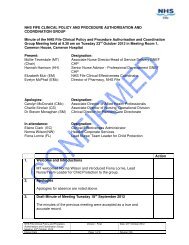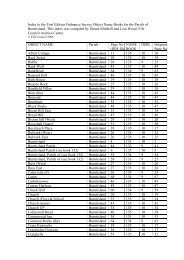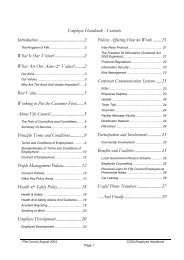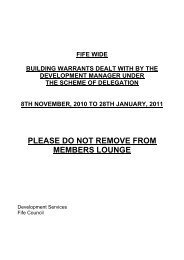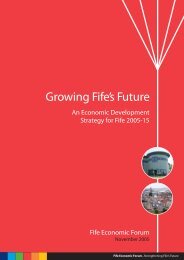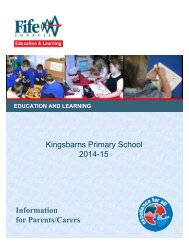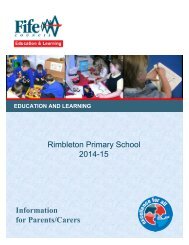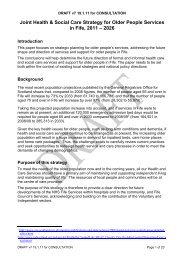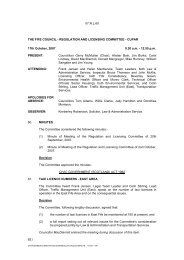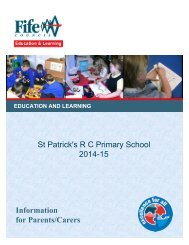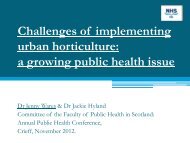DUNFERMLINE HIGH SCHOOL PROSPECTUS - Home Page
DUNFERMLINE HIGH SCHOOL PROSPECTUS - Home Page
DUNFERMLINE HIGH SCHOOL PROSPECTUS - Home Page
- No tags were found...
You also want an ePaper? Increase the reach of your titles
YUMPU automatically turns print PDFs into web optimized ePapers that Google loves.
Dunfermline High SchoolHandbook 2010/2011CONTENTS<strong>Page</strong>Introduction 1Contents 2-3<strong>SCHOOL</strong> INFORMATION 4Contacting the School 4The School Year - Session 2010-2011 5Teacher In-Service Days 5Introducing Dunfermline High School 6-7School Mission Statement & Aims 8The School Day 9Unexpected Closures 10Staff List 11-14<strong>SCHOOL</strong> ORGANISATION 15Associated Primary Schools 15The Parent Council 16Management Structure 17The School Resource Centre 17Senior Management Team 18Community Use of School 19PERSONAL AND SOCIAL NEEDS OF PUPILS 20The Pupil Support System (Guidance) 20The House Teams 21Behaviour Support 21Personal and Social Education 22The Prefect System 23Pupil Council 23Careers Guidance 24Communication with Parents 25Helping Your Child in School 26School Uniform/School Dress Code 27School Shop 29Moving to another Area 29Complaints Procedure 29Education Maintenance Allowance 30School Meals 302
Dunfermline High SchoolHandbook 2010/2011<strong>Page</strong>BEHAVIOUR AND DISCIPLINE 31Code of Behaviour 31Attendance and Absence 32Care of Books and Equipment 32Security 33THE CURRICULUM 34Curriculum Outline 34Learning Support Services 35The Curriculum: S1 and S2 36The Curriculum: S3 and S4 37-38The Curriculum: S5 and S6 39-40EXTRA-CURRICULAR ACTIVITIES 41-46APPENDIX 1 47The Class 6 Commitment Form 47The Class 5 Commitment Form 48APPENDIX 2 49Anti-Bullying Policy 49-52APPENDIX 3 53Interpreting Statistics 53APPENDIX 4 54Information for Parents 54Dunfermline High SchoolTRANSFERRING EDUCATIONAL DATAABOUT PUPILS 563
Dunfermline High SchoolHandbook 2010/2011THE <strong>SCHOOL</strong> YEAR - SESSION 2010-20111. TermsAutumn: Monday 16 August 2010 (teachers)} to Friday 15 October 2010Wednesday 18 August 2010 (pupils)Winter: Monday 1 November 2010 to Tuesday 21 December 2010Spring: Wednesday 5 January 2011 (teachers)Thursday 6 January 2011 (pupils)} to Friday 1 April 2011Summer: Monday 18 April 2011 to Friday 1 July 20112. HolidaysAutumn: Monday 18 October 2010 to Friday 29 October 2010Christmas:Wednesday 22 December 2010 to Tuesday 4 January 2011 (teachers)Wednesday 5 January 2011 (pupils)February: Thursday 17 February 2011 to Friday 18 February 2011Spring: Monday 4 April 2011 to Friday 15 April 2011Good Friday: Friday 22 April 2011May Day: Monday 2 May 2011June: Monday 6 June 20113. In-Service Training Days for TeachersMonday 16 August 2010Tuesday 17 August 2010Friday 19 November 2010Wednesday 5 January 2011Wednesday 16 February 2011Tuesday 7 June 20115
Dunfermline High SchoolHandbook 2010/2011INTRODUCING <strong>DUNFERMLINE</strong> <strong>HIGH</strong> <strong>SCHOOL</strong>AN ILLUSTRIOUS PASTDunfermline High School is one of the few secondary schools in Scotland whichcan trace its history back to the Early Middle Ages. When David I, son of QueenMargaret and Malcolm Canmore, founded Dunfermline Abbey in the 1120s, hemade provision for a monastic Grammar School to secure the education, in Latin,of future monks in the town. The School remained in the confines of the Abbey forseveral centuries.In 1468 Abbot Richard de Bothwell established Dunfermline Grammar School inthe town itself, close to the Post Office, a site it was to occupy for the next fourcenturies. One of the early ‘Masters’ was the poet, Robert Henryson. The comingof the Reformation in 1560 saw the destruction of the Abbey and the ending ofschooling there.When King James VI married Anne of Denmark in 1589, he gave her the Regalityof Dunfermline, including the Abbey and the Grammar School as a wedding gift.In 1610 she endowed the School with £100 Scots per annum in perpetuity, to bepaid to all Masters. (The money has since gone to fund ‘The Queen Anne Medal’ atthe School’s annual awards ceremony.)The Great Fire of 1624 which destroyed many buildings in the town also claimedthe School, but within a year a new building had been erected, again on the samesite in the centre of town. In 1877 the Scottish Education Department listed it as asenior secondary school and it became known as Dunfermline High School.In 1886 the High School eventually outgrew its 400-year-old site and moved to“commodious new premises” erected by public subscription in Priory Lane at acost of £7,807 and under the control of the Burgh School Board. The old title of‘Master’ was replaced by Rector. Despite the acquisition of buildings from theneighbouring Lauder Technical College, new premises were again sought and inJune 1939, just before the outbreak of World War II, the school moved to its presentsite at St Leonard’s Place, but still in view of the Abbey whose rich history itshared for so long. The building cost over £50,000 to erect and was designed to accommodate950 pupils and 43 staff.Yet again, overcrowding occurred and extensions were built in 1959 and 1979 tocater not only for the post war ‘baby boom’ but also for a much more diversifiedcurriculum. In the late sixties and early seventies the School, in line with nationalpolicies, changed its status from that of a selective senior secondary to that of acomprehensive, catering for all pupils from its immediate catchment area, plusKincardine and parts of Rosyth.Today it is a flourishing community where almost 2000 people work. The School isjustly proud of its past and it looks with confidence to the future.6
Dunfermline High SchoolHandbook 2010/2011The long, chequered history of Dunfermline High School is reflected in its badge,worn by pupils on their uniform. It also helps explain the origins of the names ofour House system. The design of the badge is quite intricate and, indeed, has beenregistered with the Lord Lyon, King of Arms in Edinburgh.This is the Coat of Arms of Dunfermline Burgh withwhich the School has long been associated over thecenturies. The central building depicts the Tower ofMalcolm Canmore. The fortress was built on rock andsurrounded by rock and guarded by two lions rampant.Queen Margaret became Malcolm’s wife andexerted a civilising influence on her new subjects.The “Cross and Martlets” (Doves) becameher emblem and reminds pupils of the school’sorigins in the Abbey.The Trefoils and the Chevron come from the coat ofarms of Abbot Richard de Bothwell, founder of theGrammar School in the town itself. Both symbolsrepresent the essential link the Grammar Schoolprovided between the Monastic School and the HighSchool. The colours of the chevron have been alteredslightly - to black and gold, the school’s colours.The origin of the other House, Henryson, has been referred to, but does not featureon the badge.The Badge carries two mottoes, in Latin:Labor Omnia Vincit- Work Conquers EverythingQuidquid Agis Age Pro Viribus- Whatever You Do, Do It With Vigour7
Dunfermline High SchoolHandbook 2010/2011<strong>SCHOOL</strong> MISSION STATEMENT AND<strong>SCHOOL</strong> AIMSMission StatementDunfermline High School seeks to provide education of the highest quality for all students inour school community in order to meet their educational, personal and social developmentneeds and prepare them to make an effective contribution to society in their present and futurelives.School Aims(a) To provide opportunities for students to develop their knowledge, understanding, skills andpersonal and social qualities to their maximum potential.(b) To assess and monitor student’s learning on an ongoing basis and set appropriate challengesand targets.(c) To provide for the emotional, physical and social needs of individual pupils.(d) To provide a broad and balanced curriculum which offers an appropriate range of highquality courses.(e) To provide a range of learning and teaching approaches which are suited to students ofdiffering needs and abilities.(f) To provide a structured, positive, supportive, secure, caring, fair and happy environment inwhich students, teaching staff and support staff can work effectively together.(g) To develop in students:Positive and caring attitudes towards their surroundings.Responsibility for their own learning.Tolerance, concern and respect.Understanding of the needs of others and of society.Understanding of their role and responsibility towards local and global perspectives and issues(h) To provide opportunities for effective staff development to meet identified needs.(i) To develop students’ self-awareness and awareness of the opportunities in education,training and employment available to them after leaving school and ensure they are wellprepared to take advantage of these and for their future roles in society.(j) To encourage and develop positive partnerships with parents and the wider community.(k) To identify, provide and use resources effectively in meeting the needs of students.(l) To monitor and evaluate the work of the school on an ongoing basis and use improvementplanning to manage targets and priorities.(m) To actively encourage the whole school to increase control of their physical, social, spiritual,mental and emotional well being and continually review all resources and systems within theschool which impact upon the health of staff and pupils.8
Dunfermline High SchoolHandbook 2010/2011THE <strong>SCHOOL</strong> DAYThe school session for pupils consists of 189 days. For members of staff it is 195days. The six extra days are used for in-service training.The school day currently begins at 9.00 a.m., finishes at 3.40 p.m. and consists ofsix periods detailed below:8.55 a.m. WARNING BELL9.00 a.m. - 9.12 a .m. REGISTRATION9.12 a.m. - 10.05 a.m. Period 110.05 a.m. - 10.58 a.m. Period 210.58 a.m. - 11.18 a.m. INTERVAL11.16 a.m. WARNING BELL11.18 a.m. - 12.11 p.m. Period 312.11 p.m. - 1.04 p.m. Period 41.04 p.m. - 1.54 p.m. LUNCH1.49 p.m. WARNING BELL1.54 p.m. - 2.47 p.m. Period 52.47 p.m. - 3.40 p.m. Period 6Pupils are expected to arrive punctually at the beginning of morning and afternoonschool and also at the beginning of every lesson.9
Dunfermline High SchoolHandbook 2010/2011UNEXPECTED CLOSURES OF <strong>SCHOOL</strong>Since 1st November 2006, Fife Council has continued to make it easier for you tofind out if your school is closed. You can also access information on road closuresand other key Council service closures.The News Centre (www.fifedirect.org.uk/news) gives details of all the latest schoolclosures’ information plus a range of other information including winter advice,services, activities as well as weather and travel updates for Fife. This is anotherway to access all the latest information during severe weather.As early as possible on the morning of severe weather or other situations such aswater, heating and building problems, there will be an update of what informationis available and that parents can access from their home. Further updates will begiven throughout the day.So when severe weather starts you should:• Listen to Kingdom FM (95.2 and 96.1), Radio Forth (97.3), Radio Tay (102.8 and96.4) or other local radio stations.• Or call the Council’s Closure Line on 08451 55 11 99.• Or log on to www.fifedirect.org.uk/news• Or access the information on your Sky or Virgin digital set-top box. See ‘FifeCouncil TV’ on the A-Z of Services on www.fifedirect.org.uk, or in UsefulGuide to Council Services.•Parents can receive text or email alerts sent direct regarding school and othercouncil facility closures. Please note if your child has moved from a primaryschool to a high school in August you should amend the school details on FifeDirect to ensure you receive the correct school information.Log on to www.fifedirect.org.uk/closuresClick on Closure AlertsClick on School Closure Alerts and follow the instructions to either sign in orregister.PLEASE USE THESE OPTIONS BEFORE TRYING TO CALL YOUR <strong>SCHOOL</strong>:FOR PARENT/CARERS:Using Fife Council Closure Line:a) Call 08451 55 11 99b) Choose Option 1 for Schools Informationc) Choose: 1 - for Kirkcaldy Schools2 - for East and Levenmouth Schools;3 - for Cowdenbeath, Glenrothes orLochgelly Schools4 - for Dunfermline, Inverkeithing andWest Schoolsd) Then choose: 1 – for Primary2 – for Secondary3 – for Other Establishmentse) Schools will be listed in alphabetical order so listencarefully for your school10
Dunfermline High SchoolHandbook 2010/2011STAFF LIST : 2010 - 2011SENIOR MANAGEMENT TEAMRECTOR:Mr Brian BlanchflowerDEPUTE RECTORS: Mr Iain MacLeod HENRYSONMr Mike McInallyQUEEN MARGARETMrs Louise RamsayBOTHWELLMr Dave WatsonCANMOREMrs Christine BentleyBUSINESS MANAGER:Ms Erica ChungDEPARTMENT HEAD OF DEPARTMENT TEACHERSART & DESIGN Mr Rab Walker Miss Denise Charlton ) (0.6 fte)Mrs Lindsey Hunter-WilsonMs Briana DruryMiss Louisa SheppardBEHAVIOUR SUPPORT SERVICE Ms Gill Gavin Miss Stella DouglasMrs Leigh Barclay (PT Guidance)BIOLOGY Mrs Kate Russell (PT Curriculum) Mrs Jill Higgins )Mrs Liz Thompson) Job shareMrs Vivienne SneddenMrs Deanne Wilson (0.8 fte)Mr Mark WilsonMrs Stephanie McCouatMrs Patricia McIntyreBUSINESS STUDIES Mr Gordon Wood (PT Curriculum) Mr Alan WilsonMrs Victoria RussellMs Carol Anne MurrayMs Marion CampbellMs Jenna FerrieCHEMISTRY Mr Kenneth Connolly Mr Alan DrysdaleMr Joe McKeownMr Chris SneddonMr David MonteithCOMPUTER STUDIES Mr Gordon Wood (PT Curriculum) Mrs. Gayle Rae (PT Guidance)Mr John HowardMrs Doreen RossboroughMr Duncan McBrideDRAMA & MEDIA STUDIES Mrs Louise Dalgleish Miss Gemma CookMs Frances RankinENGLISH/LITERACY Miss Claire Watson (PT Curriculum) Mrs Linda Thomson (Principal Teacher)Ms Katherine BrayMr Malcolm AlexanderMr Iain BlackMrs Ray MorrisonMs Rosemary Davidson (0.8 fte)Miss Rachel HamiltonMiss Rachel MichieMr Liam ScottMs Karin LaurieMiss Lindsey OwenMs Naomi Rossetter11
Dunfermline High SchoolHandbook 2010/2011GEOGRAPHY Mr John Blackwood Mr Richard Ward (Principal Teacher)Mr Andrew MercerMrs Christine Robertson (PT Guidance)HISTORY Mrs Jodie Hannan Miss Lucy McIntosh(PT Curriculum)Mr Andrew StenhouseMs Laura TitlowMs Jennifer LaingHOME ECONOMICS Miss Louise Whitehead Mrs Diana Hamilton(PT Curriculum)Miss Arwen FeltonMrs Andrea PatersonMrs Claire EvansMrs Heather Milligan (0.2 fte)LEARNING SUPPORT SERVICE (LSS) Mrs Anne Horne Mr Tom BlackMrs Louise ParmarMATHEMATICS/NUMERACY Mr Christopher Nangle Mr Charles Ramsay (Principal Teacher)(PT Curriculum)Mr Malcolm CattanachMr Iain ClarkMiss Arlene FotheringhamMr Ian LawrieMr James RiddellMr John GoodallMrs Helen Rongong (0.6 fte)Ms Teresa Vala PintoMrs Susan ListerMrs Helen OglesbyMiss Claire MacKeanMODERN LANGUAGES Mr Donald Smeaton Mrs Joanne Lindsay (Principal Teacher)Mr James Peat (Principal Teacher)Mr Peter DoolanMr Frank McAvinueMr Gavin StewartMr Fraser ReaperMs Nia Savage )Mrs Jennifer Fenelon ) Job ShareMODERN STUDIES Mr Gerard Hutchison Mrs Mairi Waugh (Principal Teacher)Mr Graeme BrownMiss Barbara AntosikMUSIC Mr John Gourlay Miss Fiona BlackMiss Fiona MillerMr Richard HardyInstrumental Instructors Miss Russell Mr ChamberlainMrs GrayMr KeaneMr CuthbertsonMrs MathesonMrs HaytonMr WoodMrs Hedley12
Dunfermline High SchoolHandbook 2010/2011PHYSICAL EDUCATION Mr David Barclay Mr John Gardner (Principal Teacher)(PT Curriculum)Mr Andrew GarryMiss Lisa BeattieMr Steve MerrettMrs Mary Murphy (Principal Teacher)Mr Steve Gardiner (PT Guidance)PHYSICS Mr John Gibb Mr Fraser Donnelly (PT Guidance)Mr Tony HodgkinsonMs Anne Moss (PT Guidance)Mr Stephen TrewarthaMs Pauline HoggRELIGIOUS& MORAL EDUCATIONTECHNOLOGYMrs Jodie Hannan (PT Curriculum) Mrs Katrina NaismithMr Robert RichardMiss Diane MackieMr Jim Macalpine (PT Curriculum) Mr John NeilMr Kenneth MunnochMr Alistair SimeDr Elizabeth FoleyThe school is also supported by the following staff:<strong>SCHOOL</strong> OFFICE Mrs Mary Grandon Administrative Co-ordinatorMrs Sheena CurrieAdministrative AssistantMs Sharon BarrClerical AssistantMrs Janette BensonClerical AssistantMs Tracey CollClerical AssistantMrs Kate DoreyClerical AssistantMrs Janice FlemingFirst Aider/Clerical AssistantMrs Sheila GrayClerical AssistantMrs Jan KubrychtClerical AssistantMrs Evelyn McAugheyClerical AssistantMrs Ann MathersClerical AssistantMiss Justine TaylorClerical AssistantMiss Kirsten RhodesClerical AssistantTEACHING AUXILIARIES Mrs Jenny Stewart Behaviour SupportMrs Fiona RendellBehaviour SupportMrs Catherine FaganBehaviour SupportMs Angela MitchellBehaviour SupportMs Lynne FerrieBehaviour SupportMrs Heather Dow<strong>Home</strong> EconomicsMrs Fiona StewartLearning SupportMiss Angela YoungLearning SupportMrs Muriel TurkLearning SupportMrs Jill LamondLearning SupportMs Lorraine ThomasLearning Support13
Dunfermline High SchoolHandbook 2010/2011PUPIL SERVICES MANAGERMs Til PeterHOME/<strong>SCHOOL</strong> LINK OFFICER Miss Denise Allan (shared with WoodmillHigh School)LIBRARIAN Ms Nicola Bett Library Supervisor<strong>SCHOOL</strong> NURSE<strong>SCHOOL</strong> COUNSELLORMrs Gill WilliamsMs Lisa Bremner<strong>SCHOOL</strong> TECHNICIANS Mr Scott Lauder Senior TechnicianMrs Julie CurranTechnicianMr Alan PurvesTechnicianMr Allan RichardsonTechnicianMr Andrew GrayTechnicianJANITORSHEAD CLEANERMr Frank McGawMr Steven WoodMrs Sandra HuttonMr Louis HendersonMrs Mary Thomson<strong>SCHOOL</strong> MEALS SUPERVISOR Mrs Tracey McAlpineINCLUSION UNIT WORKERS (APEX) Mrs Karen PrydeMrs Lynne Proctor14
Dunfermline High SchoolHandbook 2010/2011<strong>SCHOOL</strong> ORGANISATIONASSOCIATED PRIMARY <strong>SCHOOL</strong>SPupils from the following Primary Schools within the catchment area will visit theschool on organised tours during their Primary 7 year:Camdean Primary SchoolCanmore Primary SchoolCommercial Primary SchoolKing’s Road Primary SchoolPitreavie Primary SchoolSt Leonard’s Primary SchoolTulliallan Primary SchoolAll first year pupils are placed in the House System for pastoral care purposes. Theywill usually be in the same House as older members of their families. It is hopedthat pupils may be able to continue friendships formed in the primary years in theirclasses as well as developing a wider group of acquaintances.Visits from pupils coming from other schools are welcomed.15
Dunfermline High SchoolHandbook 2010/2011THE PARENT COUNCILBACKGROUND:The Parental Involvement Act (2006) represented a developmentof the previous School Board’s legislation to attempt to supportthe involvement of a wider range of parents/carers as partners intheir child’s education.All parents/carers of children enrolled into Dunfermline HighSchool are now known as the “Parent Forum”.The representative body chosen by the “Parent Forum” is knownas the “Parent Council”.Dunfermline High School’s Parent Council has an agreed Constitution.There can be up to 40 people on the Parent Councilplus the Rector and any local Councillors who wish to attend aparticular meeting. Parents must always be in the majority onthe Parent Council – currently there are over 30 parent members.Other people have been coopted onto the Parent Council includingcommunity-use, local police, local businesses and the localcommunity. The existing Dunfermline High School Associationand the Black & Gold Club continue to exist as “subsets” of theParent Council.Meetings are held every six weeks on Mondays from 6.45pm –8.15pm in Room M28.CONTACTING THE PARENT COUNCIL:If you have any queries or concerns which you wish to raise with the Parent Council,please contact SHEENA CURRIE (Secretary) on 08451 555555 (EXT 490698) or byemail (sheena.currie-dn@fife.gov.uk). Alternatively, please contact the Chairperson,Mrs Mhairi Weir (hmweir@live.co.uk).“TOGETHER WE CAN MAKE A DIFFERENCE”16
Dunfermline High SchoolHandbook 2010/2011MANAGEMENT STRUCTUREThe Rector has responsibility for school policy, leadership, management and administration.He is currently assisted and supported by five Depute Rectors. Allmembers of the senior management team have responsibility for various aspectsof whole school administration, curriculum development, discipline and pastoralcare. In addition four of the Depute Rectors have specific responsibility for yeargroups.Mrs Ramsay is in overall charge of Pupil Support in the School.There are fourteen Principal Teachers in the school who are responsible for eachof the subject departments as well as a Principal Teacher of the Learning SupportService (LSS), and a Principal Teacher in charge of the Behaviour Support Service(BSS). In addition there are eight curriculum leaders and eight other PrincipalTeachers (subject) who have department responsibilities.Pupil Support is principally the domain of the Pupil Support Staff, a team whichconsists of eight Principal Teachers of Guidance and PTs in LSS and BSS.THE <strong>SCHOOL</strong> RESOURCE CENTREThere is an excellent library/resource centre housed at the heart of the school.Pupils are encouraged to use it for personal study and reading in addition to its useas a curricular resource. The library is staffed by Ms Nicola Bett who is available tohelp with resource enquiries.17
Dunfermline High SchoolHandbook 2010/2011SENIOR MANAGEMENT TEAMMr Brian BlanchflowerRectorMr Iain McleodDepute Rector(Henryson House)Mr Mike McInally Mr David Watson Mrs Louise RamsayDepute Rector Depute Rector Depute Rector(Queen Margaret House) (Canmore House) (Bothwell House)Mrs Christine BentleyDepute RectorMs Erica ChungBusiness Manager18
Dunfermline High SchoolHandbook 2010/2011<strong>DUNFERMLINE</strong> <strong>HIGH</strong> <strong>SCHOOL</strong> COMMUNITY USEIn the early 1980s, Fife Council Community Services built the new Games Halland Swimming Pool within the school grounds. This was part of the strategy forwider community use of schools that was then being implemented.Since then Dunfermline High Community Use has gone from strength to strengthand is now the busiest community use school in Fife, and one of the busiest inScotland.Dunfermline High Community Use provides a wide range of Learning for Fun,Learning for Leisure and Learning for Work Courses for all ages. Dunfermline HighSchool pupils have taken advantage of Learning for Work Courses in completingemergency first aid, lifeguard qualifications, sign language certificates and sportscoaching qualifications. These have lead to part time employment for some pupilsworking for Dunfermline High Community Use. Anyone aged 16+ can takeadvantage of the government ILA funding which helps to cover the cost of somecourses.A range of coaching activities is also arranged where possible during school holidays.Opening hours are as follows:-Monday to Friday inclusive: 5.15pm to 10.00pmSaturday:Sunday:9.00am to 2.00pm9.30am to 2.00pmFurther information may be obtained from the Community Use Reception at01383 602 348.Trish MastertonHead of Community Use19
Dunfermline High SchoolHandbook 2010/2011PERSONAL AND SOCIAL NEEDS OF PUPILSTHE GUIDANCE SYSTEMThe Guidance system is intended to help pupils to make the most of themselves,and to take the fullest advantage of the opportunities available to them. Supportwill be given throughout school to help pupils make decisions and cope withproblems at key stages. Parents and teachers contribute a great deal to the generalsupport which pupils experience. In addition, Dunfermline High School has ateam of specialist Guidance Staff who have responsibility for monitoring progress,behaviour and attendance.Through Guidance Staff pupils also have access to additional services (e.g.educational psychologists, social workers) when specialist support is required.Parents are encouraged to contact Guidance Staff at any time if they have concernsabout which they would like advice either by writing or by telephone.Parents can make an appointment to meet Guidance Staff by contacting the schooloffice, telephone number 01383 602402. Letters should be addressed to the appropriateGuidance Teacher, Dunfermline High School, St Leonard’s Place, Dunfermline,Fife KY11 3BQ.Pupils are allocated to one of four Houses on enrolment. Each House currently hasa Depute Rector (Head of House) and two Guidance Staff.20
Dunfermline High SchoolHandbook 2010/2011THE HOUSE TEAMSBOTHWELLMrs Louise Ramsay Depute Rector Q12Mrs Leigh Barclay Principal Teacher Q14Mr Steve Gardiner Principal Teacher Q14CANMOREMr David Watson Depute Rector M45Mrs Christine Robertson Principal Teacher M46Mr Fraser Donnelly Principal Teacher M46HENRYSONMr Iain MacLeod Depute Rector Q5Mrs Gayle Rae Principal Teacher Q26Mrs Andrea Paterson Principal Teacher (Acting) Q26QUEEN MARGARETMr Michael McInally Depute Rector M16AMs Anne Moss Principal Teacher Q25Mr Liam Scott Principal Teacher (Acting) Q25BEHAVIOUR SUPPORTThe Behaviour Support Service is a service which deals with pupils who experienceserious social, emotional and/or behaviour difficulties and whose problemsare such that they have difficulty in coping in school. Support Service staff workclosely with teachers and agencies such as the Psychological Service and the SocialWork Service. The aim of the service is to give more intensive support to identifiedpupils. Pupils may attend the base on a part time basis, or may have specialsupport in the classroom.21
Dunfermline High SchoolHandbook 2010/2011PERSONAL AND SOCIAL EDUCATIONThe aims of the personal and social education courses are to help pupils to:take increasing responsibility for themselves;respect and care for others;participate effectively in society.In order to cover all areas of personal and social skills we provide structured coursesfrom S1 to S6. These courses include Health, Sex Education, Careers Guidanceand Social Issues. They provide opportunities for pupils to build up knowledgeabout themselves and the world around them and to acquire the skills to deal withdecision making. If a parent/carer wishes to withdraw a child from the sex educationprogramme he/she should contact the Rector.S5/S6 pupils are given the opportunity to attend lectures given by a number ofexternal speakers with a wide variety of specialist subjects and an extensive rangeof expertise.22
Dunfermline High SchoolHandbook 2010/2011THE PREFECT SYSTEMAnother formal aspect of the school’s pupil development programme is its Prefectsystem. The office of Prefect is open to pupils in Class 5 and 6 who are prepared totake on the responsibility of assisting staff in maintaining good order and disciplinewithin the school. They are expected to set an example to all pupils in attitude,behaviour and appearance and in commitment to the school and its ethos. Prefectduties include lunch-time supervision of the school’s two dining halls, door dutyand assisting with events such as Parents Evenings and Open Evenings. Being aPrefect brings both responsibilities and rights and includes the use of inter-personaland social skills. Pupils who feel they can make a valuable contribution to schoollife in this way apply to become Prefects.PUPIL COUNCILIn order to encourage participation and citizenship, all pupilsat Dunfermline High School are given a say in choosingtheir House Representatives. Pupils may nominatethemselves and, if necessary, elections can take place.There are three House Reps’ Meetings per year each followedtwo weeks later by the whole-school Pupil CouncilMeeting. All these meetings are chaired by seniorpupils. Training in chairing meetings and taking minutesis provided. Successful lobbying has resulted in, amongother things, the introduction of lockers for senior pupils.Visits by S5 students to S4 Social Education classes to talkabout the transition from Standard Grade to Higher alsocame from the request of pupils.23
Dunfermline High SchoolHandbook 2010/2011CAREERS EDUCATIONThe school offers a Careers Education Programme as part of the Social Education curriculum.The programme starts with a short introduction in S1 and then covers relevanttopics such as subject choice, the world of work and information on further andhigher education. A major part of this programme is Aware, a 5 day work experiencearranged by the school where it is hoped the pupil will take part in a work placement.The school has a Careers Library situated within the Main Library and contains acolour coded Careers Resource including college and university prospectuses andguides, job descriptions, careers information and ‘gap year’ materials.The modern suite of PCs in the Library provide access to Careers Interest Guidessoftware such as Kudos and Careerscape, as well as internet access to key web basedCareers Resources such as the Careers Scotland website.During the year senior pupils will be offered support in choosing and applying forCollege and University courses with relevant support from both Careers Advisers andSchool Staff. The pupils will be made aware of Open Days and allowed to attend ifparental permission is given. The School also organise a coach trip the Fife HigherEducation Convention organised by UCAS and Careers Scotland.CAREERS ADVICEThe School is supported by Careers Scotland Careers Advisers who work specificallywith the School, Anna May Hocking and Michael Leckie. Any S4 pupil who wishesto leave school will be guaranteed the opportunity to have an interview with a careersadviser, while all S4, S5 and S6 will have the option of an interview but need to selfrefer. All post school options are suitable for discussion.Pupils can request an interview with the Careers Advisers either by completing a ContactCard in the School Library, or through the Guidance Staff; in addition it is possibleto speak with an Adviser at the Career ‘drop-in’ session in the Library on Monday,Tuesday or Thursday at lunchtime.The Careers Advisers will also provide Careers Groupwork with different year groupsto support and compliment the Careers Education programme, a part of the SocialEducation described above.Parents can arrange to meet with the Careers Advisers either at S2, S4, S5 or S6 ParentsEvenings, via the Guidance Staff, or by calling the Careers Advisers directly at the DunfermlineOpportunity Centre, 15 East Port, Dunfermline; tel 01383 602378.24
Dunfermline High SchoolHandbook 2010/2011COMMUNICATION WITH PARENTSWe believe that education should be a partnership of pupils, teachers and parents.Teaching methods throughout the school involve teachers and pupils in a dialogueabout the individual’s progress. Parents are informed of their child’s progress inregular written reports and orally at annual parent-teacher interviews.Regular communications from the Rector giving details of forthcoming events or ofany topical matters in the school are made from time to time. On some occasionsit is necessary for the school to write to the parents of individual pupils about matterswhich have arisen in school. Parents should address correspondence aboutpupils to the appropriate Guidance Staff or, if desired, to the Rector. The school’saddress is St Leonard’s Place, Dunfermline, KY11 3BQ. The school’s telephonenumber is 01383 602402.25
Dunfermline High SchoolHandbook 2010/2011HELPING YOUR CHILD IN <strong>SCHOOL</strong>DISCUSSION PROBLEMSIf difficulties or problems arise in school, be they social or educational, the parentis often the first to know. Talk things over with your child and if you feel thatthe school could help to resolve matters, please feel free to get in touch with yourchild’s Pupil Support Teacher. Similarly, if a problem has arisen at home whichmight affect your child’s work in school, contact the Pupil Support Staff. In theteenage years relatively minor problems can seem very important. Our aim is thatparents and teachers in partnership can help children gain the maximum from theireducation.<strong>SCHOOL</strong> WORKYoung people are often very reluctant to tell their parents much about life in schooland parry all questions about school with answers like, “Fine”. There is, however,plenty of evidence to suggest that children do better in school when their parentstake an active interest in what they are doing.SOME IDEASAsk your children to show you their homework diary, with which all pupils areissued. Discuss the homework they are given, check to see that it is well done.Ensure that children get into good study routines at home and that they preparefor the next day by checking over classwork and assembling the correct books andmaterials. If children tell you that they have no homework, feel free to contact theschool to check on this. Encourage your child to study and particularly to read if heor she does not have set homework to do.GENERALIf you can manage, make time to listen to your children. Find out what reallyinterests them and discuss their and your opinions on things. On occasions, if youwatch a television programme or video film together, why not discuss it? Encourageyour child to read. School books are important, but novels and newspapersare also very valuable. Encourage your child to talk about what he or she reads,watches or participates in.THE <strong>SCHOOL</strong>’S HOMEWORK POLICY<strong>Home</strong>work should be given methodically and regularly in school in order to reinforceclassroom learning and to encourage independent study habits. The amountof homework will vary depending on the child’s course and age.The school has issued homework booklets for the guidance of all parents and pupils.Please consult these.26
Dunfermline High SchoolHandbook 2010/2011<strong>SCHOOL</strong> DRESS CODEHaving a School Dress Code has a number of advantages including:-• Helping young people develop a sense of discipline and pride in a neat and tidyappearance• The creation of a positive and more professional attitude and improved reputationin the local community• The promotion of a positive school ethos and sense of identification with and loyaltyor sense of belonging to the school• The encouragement of a purposeful attitude to work and positive behaviour• Raising young people’s awareness of the requirement to dress appropriately for thecircumstance (e.g. certain work requirements, interviews etc.)• Improving security in school by aiding identification of pupils within the schoolmaking it easier to identify intruders• Assisting the identification of truants in the community• Eradicating peer pressure for young people to adhere to certain fashion items, thusreducing victimisation and bullying• Assisting parents/carers in terms of economic and practical issues (Parents don’thave to shop for expensive and varied wardrobes for their children to keep up withothers and pupils don’t have to worry about what to wear in the morning!)There are, and always have been, items of clothing which are inappropriate for schoolincluding items which:-• Could potentially encourage factions (e.g. football colours)• Could cause offence (e.g. anti-religious symbolism or political slogans)• Could cause health and safety difficulties such as loose fitting clothing or trainingshoes or particular items of jewellery• Are of flammable materials which may be a danger in certain classes (e.g. shellsuits)• Could damage floors or floor coverings.27
Dunfermline High SchoolHandbook 2010/2011Dunfermline High School has had a long tradition of school uniform and, after parentalconsultation, returned to a more traditional dress code from August 2008.The new School Dress Code consists of:Plain White Shirt or Blouse complete with a School TieBlack Trousers or SkirtSchool Shoes – NOT trainersWhen a jersey is required, this should be a black V-neck jumper, sweatshirt or cardigan(round necks or crew necks clearly cover the white shirt/blouse and tie).A ‘senior school tie’ is available to all S5/S6 pupils.S5/6 Prefects would also be expected to wear a school blazer with a school badge withcord or braid as appropriate.(The School Shop sells school ties (£3.50), Senior school ties (£5.50), blazer badges(£2.50), black V-neck sweatshirts (£10.00), girls black zip cardigans (£16.50).OTHER ESSENTIAL EQUIPMENTPupils should have a school bag or similar strong container in order that school books are givenmaximum protection. Books and jotters should also be covered. It must be made clear that careof equipment which belongs to the authority is the pupil’s responsibility. All staff will regularlycheck on the standard of work and condition of jotters. We expect pupils to keep their jottersand books ‘graffiti’ free. Every day pupils are expected to have pens, pencils, rubber, ruler andcalculator. Certain departments have specific requirements as detailed below:<strong>Home</strong> EconomicsFor each practical food lesson pupils must bring a container or a Cake Box.Physical Education KitClothing for Physical Education must be suitable and appropriate for the activity and venue.Swimming Pool activities require swimwear and a towel.Indoor activities require non-marking training shoes, a polo shirt or T-shirt and shorts ortracksuit trousers.Outdoor activities have the same requirements as indoor activities but a sweatshirt or atracksuit may be sensible additions in colder weather.For health and safety reasons, this clothing and footwear should be changed into and outof each lesson. Jewellery must also be removed.School Team Colours could be purchased for PE to avoid unnecessary duplication andadditional costs. These are a gold top, black shorts and gold socks (all of which are alsoavailable from the School Shop).28
Dunfermline High SchoolHandbook 2010/2011<strong>SCHOOL</strong> SHOPThe School Shop was opened to provide the parents of the pupils of DunfermlineHigh School with the opportunity to purchase school uniform at a reduced cost.The shop provides a range of leisure wear suitable for physical education withinthe school, in particular sports socks and hockey tops.The School Shop may be found by entering the school by the main door and followingthe appropriate signs to the Main Office.Opening Times:Monday - Friday from 8.30am to 4.00pm.MOVING TO ANOTHER AREAIf you move out of the school’s catchment area, you are required to make a placingrequest asking that your child continue his/her education at Dunfermline HighSchool. Such requests should be made in writing and addressed to the Rector.Please note that any travelling expenses incurred as a result of moving out of thecatchment area are normally borne by the parents unless the pupil is in his or herthird, fourth, fifth or sixth year.COMPLAINTS PROCEDUREDunfermline High School operatesto clearly defined standardsof service so we hope that pupilsand parents will encounter noproblems. However, if a mistakeor misunderstanding arises theEducation Service of Fife Councilhas a straightforward complaintsprocedure. A leaflet explainingthis procedure can be obtainedon request from the school.29
Dunfermline High SchoolHandbook 2010/2011EDUCATION MAINTENANCE ALLOWANCEAny pupil who reaches the age of 16 between 1st March and 30th September 2010could be eligible for an award starting at the beginning of the new term in August2010. Forms will be available from School from May 2010.<strong>SCHOOL</strong> MEALSThe school has two dining halls, used by all year groups. A very wide choice ofmeals and snacks is available, prepared in the school kitchen. Payment is madeusing the MYFIFE Cash Loaders in Reception and in M & J Blocks. No cash is acceptedin the Dining Hall.A “Healthy Eating Van” (run by Fife Council) is also available in the SchoolGrounds. Cash is accepted here.FREE <strong>SCHOOL</strong> MEALSMany pupils are entitled to free school meals. Entitlement is dependent on netweekly income after allowances are made for tax, superannuation, rent, communitycharge, etc. in accordance with scales agreed by the Authority. If your familyreceives Family Credit your children, on application, automatically qualify for freelunches. Application forms detailing conditions are available from the Local Officeof Fife Council at 82 High Street, Dunfermline.TUCK SHOPAt interval and lunch time a “healthy eating” school tuck shop operates from insidethe Dining Hall. Items can be purchased from a number of vending machines. Allprofits from this operation are donated to the School Fund.Pupils are not allowed to leave the school grounds at morning interval.SNACK BARAt morning interval a snack bar is operated in the school dining halls.Chewing gum is not allowed on the school premises and we would ask for parents’help in enforcing this.30
Dunfermline High SchoolHandbook 2010/2011BEHAVIOUR AND DISCIPLINECODE OF BEHAVIOUR1. Coming to School• Be on time• Bring pens, pencils, a ruler, erasers, something to carry your books andequipment in2. Inside the Building• Remember to respect the property and those who use it• Walk quietly and sensibly• Keep to the one way system• No eating or drinking• Put litter in the bins provided• Keep clear of stairs and teaching areas at interval and lunchtime• No graffiti• Do not use radios, personal stereos, cassette recorders, computer games3. Inside the Classroom• Remember to follow the Class Code of Behaviour• Be on time for class• Remove outdoor clothing• Co-operate with teachers and fellow pupils• Speak politely• Work hard• Do not eat, drink or chew4. Outside the Building• Put litter in the bins provided• Stay in the grounds at morning interval• No graffiti• No gambling31
Dunfermline High SchoolHandbook 2010/2011ATTENDANCE AND ABSENCE1. Attendance is checked at Registration each day and then by class teachers ateach period of the day.2. Absence on any day or any part of a day must be explained in a note from theabsentee’s parent or guardian to the Register Teacher. Please include child’sname, register class and ensure that the letter is dated and signed and specifiesthe period of absence.3. Pupils must not leave the school premises during school hours withoutpermission.4. Parents may wish to telephone the school to explain a child’s absence but awritten note should still be produced upon the child’s return. The school’stelephone number is 01383 602402.5. The school operates a ‘Truancy Call’ system where parents of pupils indesignated year groups will be telephoned if their child is absent without areason being given. Parents should, therefore, contact the school before 9.30a.m. if they are keeping their child off.6. LatenessPupils arriving late for the morning or afternoon sessions should collect a LateSlip from the <strong>Home</strong>/School Link Officer or Reception before joining theirclass. Pupils should ensure that the Late Slip is completed before returning it atRegistration on the next school day along with the required punishmentexercise or a note from their parents to their Register Teacher.7. The <strong>Home</strong>/School Link Officer is based in the school. When a pupil has beenabsent for three days without parents informing the school of the reasons, shewill automatically arrange to visit the home as a matter of concern. Certainpupils will receive ‘first day’ calls as requested by Guidance Staff/Heads ofHouse.CARE OF BOOKS AND EQUIPMENTFife Council supplies a wide range of resources for the use of pupils. As these arenecessarily in limited supply and are costly, they should be looked after by pupils.Books, jotters and folders issued to pupils must therefore be properly looked after.32
Dunfermline High SchoolHandbook 2010/2011SECURITYIn a school as large as this, security can be a problem. We ask for parents’cooperation in ensuring that the school is as secure as possible.• Pupils should not bring valuables or large sums of money to school.• Pupils should not bring any hazardous objects or materials to school, e.g.glass containers.• Pupils should not leave belongings unattended.• Cycles, if brought to school, cannot be guarded and are brought at theowner’s risk.• The School buildings are closed over the lunch interval except in inclementweather. Pupils should therefore not enter the buildings at this time unlessthey have an Activity Pass.• Loss or theft should be reported to a member of staff.• While small sums of money and watches may be left with P.E. Staff duringP.E. periods, the school cannot take responsibility for loss of personalpossessions. It would be advisable for pupils to leave valuables at home onthe days they are taking P.E., Games or Swimming and when representing theschool in inter-school matches.33
Dunfermline High SchoolHandbook 2010/2011THE CURRICULUMCURRICULUM OUTLINEThe secondary education of pupils divides neatly into three stages:11-14 Years 1 and 214-16 Years 3 and 416-18 Years 5 and 6A glance at the staffing list gives some idea of the range of subjects taught in theschool. Our aim across the board is to ensure that the curriculum is appropriate tothe needs of the individual pupil so far as this is possible given class sizes as theyexist and the school’s staffing complement. To ensure that this is done effectively andefficiently we are continuously monitoring, modifying and adjusting the curriculumon offer.34
Dunfermline High SchoolHandbook 2010/2011LEARNING SUPPORT SERVICESMany pupils require extra support to meet their Additional Support Needs. AdditionalSupport Needs vary according to the individual pupil. Some pupils needshort-term support to enable them to cope with the new concepts they are beingintroduced to across the curriculum. Other pupils need long-term support becausethey have severe and/or specific learning difficulties. The aim of the school is toprovide appropriate education for all pupils.The Learning Support Department is a team of teachers and auxiliaries workingwith Subject Staff,Guidance Staff and Behaviour Support Staff in order to enhance the educationalexperience for pupils with a range of learning needs.Learning Support Teachers are able to offer specialist support in the following ways:• by working in the classroom alongside the class teacher• by helping departments plan courses which meet the needs of pupils of allabilities• by helping teachers identify severe and/or specific Additional Support Needsand offering strategies for helping the pupils concerned• by working with individuals / small groups with the focus on individualtuition.35
Dunfermline High SchoolHandbook 2010/2011THE CURRICULUMS1 AND S2 - THE COMMON COURSEIn First and Second Year we aim in all subjects to build on the work done in theprimary years, preparing for the Standard Grade courses in Years Three and Four.We aim to establish good working habits and familiarity with subject approachesas well as developing particular skills and imparting knowledge.During S1 and S2 pupils become more aware of where their particular interestsand talents lie. At the end of S2, pupils, after consulting their Guidance Teachers,are able to make an informed and appropriate choice of Standard Grade or NationalQualification courses for S3 and S4. The subjects included in the CommonCourse are:EnglishMusicSciencesModern Studies<strong>Home</strong> EconomicsReligious EducationPhysical EducationFrench, German or SpanishArt and DesignMathematicsHistoryTechnologySocial EducationGeographyDramaComputing/Business EducationIt is a whole school priority at this stage to enable pupils to progress at their ownappropriate rate with teaching methodology and course content and materialsreflecting this.These are the planned curricula for Session 2010-2011 . All courses are dependenton staffing. These curricula are for the purposes of illustration only.36
Dunfermline High SchoolHandbook 2010/2011THE CURRICULUMS3 AND S4 - THE MIDDLE YEARSAll pupils are prepared in every subject for the Scottish Qualifications Authority(SQA) Standard Grade Examinations (although in a minority of cases pupils may bepresented at Access 3, Intermediate I or Intermediate 2) - these courses are completedby May in the Fourth Year. The main features of Standard Grade courses are:• Pupils are assessed in most subjects at Credit, General or Foundation level.Biology, Chemistry and Physics are offered at Credit or General levels only.• For most subjects internal assessments carried out by the school are included.• The certificate will contain a profile of the elements of each subject.Our course in Third and Fourth Year attempts to ensure that nearly all pupils willstudy English, Mathematics, a Science, a Social Subject, a Foreign Language and atleast one subject which provides Technological Training or is from the Creative andAesthetic Group.37
Dunfermline High SchoolHandbook 2010/2011<strong>DUNFERMLINE</strong> <strong>HIGH</strong> <strong>SCHOOL</strong> S3 COURSE CHOICE OPTIONS FOR 2010 (TICK YOUR CHOICES PLEASE)CORE/COL 1/COL 2 COL 3 COL 4 COL 5 FLEXIBLE COLUMNSPE, PSE & RELANGUAGE &COMMUNICATIONMATHEMATICAL STUDIES& APPLICATIONSSCIENTIFIC STUDIES&APPLICATIONSLANGUAGE&COMMUNICATIONSSOCIAL &ENVIRONMENTALSTUDIESCREATIVE & AESTHETICTECHNOLOGICAL ACTIVITIES & APPLICATIONS& OTHER COURSESCOMPULSORY CHOOSE ONE CHOOSE ONE CHOOSE ONE CHOOSE ANY THREE SUBJECTSPHYSICAL EDUCATION(Core)SOCIAL EDUCATION &VOCATIONALGUIDANCE(Core)RELIGIOUS EDUCATION(Core)ENGLISHMATHEMATICS□ BIOLOGY (G/C)□ CHEMISTRY (G/C)□ PHYSICS (G/C)□ BIOLOGY Int1□ CHEMISTRY Int1□ PHYSICS Int1□ FRENCH G/C□ GERMAN G/C□ SPANISH G/C□ FRENCH F/G□ GERMAN F/G□ SPANISH F/G□ GEOGRAPHY G/C□ HISTORY G/C□ MODERN STUDIES Int2□ R.M.P.S. Int2□ GEOGRAPHY F/G□ HISTORY F/G□ MODERN STUDIES Int1□ R.M.P.S. Int1□ ART & DESIGN (Int1/Int2)□ DRAMA (F/G/C)□ MUSIC (Int1/Int2)□ PHYSICAL EDUCATION (F/G/C)□ ACCOUNTING & FINANCE (F/G/C)□ ADMINISTRATION (F/G/C)□ BUSINESS MANAGEMENT (F/G/C)□ COMPUTING STUDIES (F/G/C)□ PRACTICAL CRAFT SKILLS (Int1)□ CONSTRUCTION (Int1)□ CRAFT & DESIGN (F/G/C)□ GRAPHIC COMMUNICATION (Int1/Int2)□ TECHNOLOGICAL STUDIES (G/C)□ LIFESTYLE & CONSUMER TECHNOLOGY(Int2)□ HEALTH & FOOD TECHNOLOGY (Int1/Int2)□ BIOLOGY (G/C)□ CHEMISTRY (G/C)□ PHYSICS (G/C)□ GEOGRAPHY (G/C)□ HISTORY (G/C)□ MODERN STUDIES (Int2)□ RMPS (Int2)□ FRENCH (G/C)□ GERMAN (G/C)□ SPANISH (Int2)□ HOSPITALITY (Int1)□ EARLY EDUCATION & CHILDCARE (Int1)(2:1:1:4:4 periods)(3 periods)(3 periods)(3 periods)(3X3 periods)PUPIL’S NAME: REG. CLASS:I wish to confirm that the subjects ticked carefully above indicate my preferred S3 & S4 Course Choice Options for my son/daughter for 2010-2012.Signed (Parents/Carer) Date: / / 2010THIS FORM MUST BE FULLY COMPLETED AND RETURNED TO THE MAIN OFFICE BY THURSDAY 4TH MARCH 201038
Dunfermline High SchoolHandbook 2010/2011THE CURRICULUMS5 AND S6 - THE UPPER <strong>SCHOOL</strong>Nearly 80% of pupils continue their education after S4, aiming for one or more ofthe following types of SQA National Qualifications:(1) Advanced Higher - normally in S6 only following success at Higher Grade(2) Higher Grade - normally available to students who have passed StandardGrade at 1 or 2(3) Intermediate Level 2(4) Intermediate Level 1The Scottish Qualifications Authority is the national body responsible for all qualificationsin Scotland. In recent years there has been a huge growth in the numberand range of subjects offered by the SQA. Many are offered in school but othersare more vocational and specialised and are offered by Further Education Collegessuch as Carnegie College or Adam Smith College.Students can use these qualifications for:• entry to employment• progression to Higher National Certificates and Diplomas (HNCs and HNDs)• moving on to Higher EducationIn Sixth Year the school offers a range of courses allowing students to attempt theAdvanced Higher in the summer of their final year. These courses are an excellentpreparation for both very specialised employment and, certainly, for Further andHigher Education.39
Dunfermline High SchoolHandbook 2010/2011<strong>DUNFERMLINE</strong> <strong>HIGH</strong> <strong>SCHOOL</strong> - SUBJECT CHOICE FORM S5/6 CURRICULUM - SESSION 2010-2011 OPTION 1 OPTION 2 OPTION 3 OPTION 4 OPTION 5Geography Chemistry Computing French Art PortfolioHistory English German Graphic Communication BiologyMathematics RMPS Music Business ManagementModern Studies NPA Acting & Performance Physics ComputingPsychologySociologySTUDY STUDY STUDY STUDY STUDYGeography Art and Design Accounting Administration AdministrationHistory Biology Computing Art and Design Business ManagementMathematics Chemistry Drama Computing ChemistryMedia Studies English English Drama ComputingModern Studies Human Biology Health and Food Tech French GeographyPE Physics Mechatronics German HistoryProduct Design RMPS PE Graphic Communication Human BiologyLCT MathematicsMusic Modern StudiesPhotographyGeography Art and Design Accounting Administration AdministrationHistory Biology Computing Art and Design BiologyMathematics Chemistry Drama Computing Business ManagementMedia Studies English English Drama ChemistryModern Studies Physics Health and Food Tech French ComputingPE RMPS Hospitality GermanPE Graphic Communication GeographyPhysicsSpanishPractical Craft Skills LCT HistoryMusic MathematicsPhysics Modern StudiesSpanish Travel and TourismHistory Art and Design English Administration AdministrationMathematics Biology Hospitality Art and Design GeographyModern Studies English Practical Craft Skills Spanish HistorySocial Education Name: Class:MathematicsInt 1Int 2Higher‘H’AdvancedHigherAVAILABLE TO S6 ONLY40
Dunfermline High SchoolHandbook 2010/2011EXTRA-CURRICULAR ACTIVITIESPupils gain a great deal from taking part in activities which are organised outsidethe classroom. A large number of staff give up time at lunchtime and after schoolto provide these additional opportunities for pupils.Up-to-date information on these activities can be found in the Daily Bulletin.Please note that the availability of these and other activities will vary from time totime depending on school staffing.<strong>SCHOOL</strong> PRODUCTIONSWe have a proud tradition of staging whole school productions. These involvepupils and staff from throughout the school in performing, lighting, props, soundspecial effects, scenery and backstage work. Pupils and staff work together on aninformal basis during lunchtime and after school to produce these events whichhave become highlights of the school calendar.Proceeds from the shows have been invested in purchasing equipment such as asound system and a video mixing disk. Pupils are trained to use these thus enhancingtheir experience. We have recently also collaborated with Adam Smith Collegeto record and produce a CD of pupils and staff singing a selection of songs fromrecent shows.Pupils participating in school productions are eligible for the award of SchoolColours.Recent Productions:December 1996 Deacon BrodieDecember 1997 Dracula SpectaculaDecember 1998 DazzleMarch 1999 Stars in Their EyesDecember 1999 GreaseMarch 2000 Stars in Their EyesDecember 2000 The Rocky Monster ShowMarch 2001 Stars in Their EyesDecember 2001 OliverMarch 2002 Stars in Their EyesDecember 2002 Little Shop of HorrorsMarch 2003 Stars in Their EyesDecember 2003 Stars in Their EyesDecember 2004 Stars in Their EyesDecember 2005 Stars in Their EyesDecember 2006 Stars in Their EyesDecember 2007 Stars in Their EyesDecember 2008 We Will Rock YouDecember 2009 Stars in Their Eyes41
Dunfermline High SchoolHandbook 2010/2011MUSIC ACTIVITIESWind BandFor pupils who already play Woodwind, Brass or Percussion Instruments. This is animportant part of learning to play these instruments; pupils will be guided by theirinstrumental instructors as to when it is suitable for them to join the Wind Band.Woodwind EnsembleThis is a group for more advanced Woodwind pupils, generally S3-S6.Mr Cuthbertson (Woodwind Instructor) selects players for this ensemble.String GroupsMrs Gray (Violin/Viola Instructor) organises groups of various levels for pupils whoalready play Violin, Viola, ‘Cello and Double Bass. This is an important part oflearning to play these instruments; pupils will be guided by their Instrumental Instructorsas to when it is suitable for them to join.S1/S2 Junior ChoirThis group is organised by Miss Miller and is for any pupil in S1 or S2 who enjoyssinging. The Choir sings exciting and fun music and will always welcome newmembers.S3-S6 Senior Mixed ChoirThis group is organised by Miss Miller and is for any pupil (male or female) fromS3 upwards.The Choir sings a variety of music which is fun and exciting.New members are always welcome.42
Dunfermline High SchoolHandbook 2010/2011USA EXCHANGEThis is a prestigious programme on bothsides of the Atlantic and has been runningsince 1981, when it was set up by the lateMr. Ken Mottram. It is now the longestrunning exchange by a school in Virginia.In early 2010, Scottish students fromthird to fifth year may apply and, after anintensive selection process, twenty fivestudents will be chosen to represent DunfermlineHigh School in Virginia at Easter2011. Students attend classes in Loudoun County High School, whilst staying withtheir hosts in their homes. We also visit many places of interest – Previous trips haveincluded Williamsburg, Busch Gardens, the White House in DC, a Nationals baseballgame and Baltimore, Maryland. June 2011 will see the second leg of the Exchangeprogramme, when the American students arrive here and repeat the process started inLeesburg.These are some comments from 2007:“The American Exchange was, without doubt, the best experience of my life!” MorvenWeir 5B1“I would recommend this trip to absolutely everyone, for I know everyone would gainsomething from the experience ….. I’m just jealous of those who still have it to lookforward to!”Kate Farrimond 6B“It’s true, this is no holiday. It’s better than a holiday.”Connor Scanlon S5“Of additional importance, I have also gained many more friends during my time inAmerica, with whom I hope to stay in contact for a very long time.”Michael Whyte S5and 2009:“Each trip benefited me as I learned more about the culture and differences of Americain an interesting way.”Rebecca Miller S4“The places we visited and the experiences we had were great and it will be hard toforget and the family were more than welcoming. All in all, I wish I could do it all overagain.”Rebecca Melville S4In 2011, both schools will celebrate the 30th Anniversary of the Exchange. 900 studentsand so many more family members have been involved in the programme, alongwith many staff.43
Dunfermline High SchoolHandbook 2010/2011EXTRA CURRICULAR ACTIVITIES 2009-10EXTRA CURRICULAR ACTIVITIES 2009-10A wide range of Extra-curricular activities is available throughout the school year. Listed below are activities which are currently available. Pupils shouldwatch A wide the range Daily of Bulletin Extra-curricular for information activities on additional is available activities. throughout This schedule the school will also year. be published Listed below on the are school’s activities website which and are will currently be updated available. regularly. Pupilswww.dunfermlinehigh.co.ukshould watch the Daily Bulletin for information on additional activities. This schedule will also be published on the school’s website and will beupdated regularly.www.dunfermlinehigh.co.ukRegular ActivitiesRegular ActivitiesName of Club/Activity Department/SupervisingstaffVenue Time ParticipantsMonday Gallery Visits Art Department Staff Out of School Seniors2 nd Year Football Mr. Barclay PE 3.45 – 5.00 2nd YearDance Club Miss Beattie Games Hall 3.40 – 4.45 S1Dance Club Miss Beattie Gym 1 3.40 – 4.45 S3/4Dance Club Miss Beattie Gym 2 3.40 – 4.45 S2Netball Miss Beattie Miss Ferrie Games Hall Lunch S2/3Young Enterprise Miss Murray Miss FotheringhamMiss FerrieM4 4.00 – 5.00 S5 - S6S1 Hockey Miss Steele PE 3.45 – 5.00 S1S1-3 Girls Football Miss Steele PE Lunch S1 - 3 GirlsS1/2 Drama Group Miss Cook Assembly Hall Lunch S1/2Eco Schools Group Mrs Waugh/Ms Chung M57 Lunch All YearsTuesdayNetball Senior Pupils L Beattie Games Hall Lunch S1S1 Football Mr Richard Mr McAvinue PE Lunch S1 BoysHockey Senior First XI Mr. Gardiner PE 3.45 – 4.45 S4 - S6 GirlsShakespeare Schools Festival Miss Cook Drama 3.45 – 5.00 S1 - 6M.A.D. Make a Difference – Eco Schools Mr. Ward M51 Lunch All YearsReading Café S1/2 Mr Black Mrs Laurie Miss Owen Library Lunch S1/2History Club Miss Hannan M12 Lunch S1/2Sketch Club Mr Munnoch P8 Lunch S1 pupils44
Dunfermline High SchoolHandbook 2010/2011WednesdayThursdayFridayX-site Christian themed club Mrs Parmar Miss Aze M48 Lunch All YearsShakespeare Schools Festival Miss Cook Drama 3.45 – 5.00 S1 - S6Hockey S2-3 Boys and Gilrs Miss L Rankin PE 3.45-5.00 S2 - S3 Boys andGirlsS1/2 Boys Rugby Mr Stewart Old Gym 3.45 – 5.00 S1/2 BoysBadminton Mrs Rae Mr Cattanach Games Hall Lunch S1 - 3Gardening Club Ms Moss / Ms Paterson Pond area Lunch All yearsCook Well Live Well Mrs Paterson P4 6.30-8.00 ParentsModern Studies Club Miss Antosik Mr Brown Modern Studies Dept Lunch All YearsDiabetes Support Group Miss Mackie M47 Lunchbi-weeklyDebating Club Mr Brown Miss AntosikMiss MacIntoshAll yearsM17 Lunch All yearsBook Group Miss Watson Mrs Bray Library Lunch S1 - 4Lunchtime Dance Club Miss Beattie Gym 1 Lunch S2/3Euroclub Mr Smeaton M28 Lunch S1Chef’s Club – cookery skills <strong>Home</strong> Economics Staff <strong>Home</strong> Ec. Department 4.00-5.00 S1/2Badminton Mr Cattanach Mrs Rae Gameshall Lunch S4 - 6Shakespeare Schools Festival Miss Cook Drama 3.45 – 5.00 S1 - 645
Dunfermline High SchoolHandbook 2010/2011Clubs and Activities held at various timesName of Club / Activity Department / Supervising Staff Venue Time ParticipantsGallery Visits Art department Various galleriesMurals in school corridorsArt department Art Dept Ask S1- S6Junior art ClubPortfolio ClubBabcock – Aircraft Carrier ProjectDAFC Stuart Adamson MuralLifelinesDance when school show is scheduled Miss Beattie Ask All yearsStars in Their EyesMrs Ramsay et al Hall by arrangement AuditionsSchool ShowComputer Club Computing Department J31 / 41a by arrangement Mainly S3/4Fantasy Football Check Daily Bulletin J40b for info. on-going All yearsMake-up for school shows etc Ms Moss Miss Ferrie Nights of shows S3 - 6S3 - 5USA Exchange – every 2 years Mrs Waugh M57 Monthly once groupselected.DHS Riding Club Ms F Rankin et al Wester DeanheadEquestrian CentreCulture Club – seminal film + theatreproduction screeningSundays All yearsMs F Rankin E5 various S5/6ARC Animal Welfare Club Ms F Rankin Drama tba All welcomeMusicWind BandDepartment StaffMusic DeptAdvised by instructorWoodwind EnsembleString GroupsMr CuthbertsonMrs GrayMusic DeptMusic DeptCheck withMusic DepartmentSelectionVarious levels selectedS1/2 Junior ChoirMiss MillerMusic DeptS1/2 welcomeS3-6 Senior Mixed Choir Miss MillerMusic DeptS3 - 6 welcome46
Dunfermline High SchoolHandbook 2010/2011APPENDIX 1………………THE CLASS 6 COMMITMENT FORMAny pupil who has opted to return to school for a Sixth Year will find this a veryimportant year. Some pupils will wish to study Advanced Higher subjects whileother pupils will wish to upgrade 'Higher' subjects, study new 'Higher' grade subjectsor obtain other SQA qualifications.All pupils who return for a Sixth Year will be expected and encouraged to developsound habits of study and at the same time to develop a sense of personaland communal responsibility. Returning to school for a Sixth Year requires 100%commitment on the part of each individual and I should be pleased if you wouldindicate this commitment by accepting and completing this document.I, ……………………………………… wish to be a member of the Sixth Year atDunfermline High School. Following consultation with my parents, Subject Teachersand Guidance Teacher I have chosen the subjects listed below. I also understandthat I must fulfil the following conditions:1. attend school regularly following all school rules including the wearing of fullschool uniform at all times.2. if absent bring a note explaining the reason for my absence. (Details of anylong termabsence should be reported to the school).3. attend ALL periods of the subjects listed below or alternative subjects if a secondchoice has to be made. This includes attending Supervised Study classes.4. work to the best of my ability to achieve good results.5. act and behave in a sensible, mature manner thus showing an example toyounger pupils.6. continue with my chosen subjects until next May unless advised by my GuidanceTeacher to 'give up' a subject. I may NOT just 'drop' a subject.I understand that if I do not abide by the above conditions my parents and Iwill be invited to meet with the Rector and/or Depute Rector (S5/6) in orderto discuss my future plans.Signed: …………………………… Class: …………….Date: …………………..Option Columnn 1 2 3 4 5SubjectLevelSignature of Parent/Guardian: ……………....……………….Date: ……………47
Dunfermline High SchoolHandbook 2010/2011THE CLASS 5 COMMITMENT FORMAny pupil who has opted to return to school for a Fifth Year will find this a veryimportant year. Some pupils will wish to take ‘Higher’ subjects only while otherswill wish to take a mixture of Higher Grade, Intermediate or Modular courses.All pupils who return for a Fifth Year will be expected and encouraged to developsound habits of study and at the same time to develop a sense of personal andcommunal responsibility. Returning to school for a Fifth Year requires 100%commitment on the part of each individual and I should be pleased if you wouldindicate this commitment by accepting and completing this document.I, ...................................................................... wish to be a member of the FifthYear at Dunfermline Teacher I have chosen the subjects listed below. I also understandthat I must fulfil the following conditions:1. attend school regularly following all school rules including the wearing offull school uniform at all times.2. if absent bring a note explaining the reason for my absence.3. attend ALL periods of the subjects listed below or alternative subjects if asecond choice has to be made.4. work to the best of my ability to achieve good results.5. act and behave in a sensible, mature manner thus showing an example toyounger pupils.6. continue with my chosen subjects until next May unless advised by my PupilSupport Teacher to ‘give up’ a subject. I may NOT just ‘drop’ a subject.I understand that if I do not abide by the above conditions my parents and I willbe invited to meet with the Rector and/or Depute Rector (S5/6) in order todiscuss my future plans.Signed: .................................................... Class: ................. Date: ..................Option Columnn 1 2 3 4 5SubjectLevelSignature of Parent/Guardian: .................................................... Date: ...................48
Dunfermline High SchoolHandbook 2010/2011APPENDIX 2ANTI-BULLYING POLICYIn Dunfermline High School we undertake to create a safe and supportiveenvironment in which pupils can receive their education.To this end bullying (1), in any form, is not tolerated.AIMS OF THE POLICY• To acknowledge that everyone (pupils, teaching and non-teaching staff) is entitled to feel safe and secure in the school environment, and that bullying isopenly acknowledged as being unacceptable.• To ensure that pupils, staff (teaching and non-teaching) and parents understand the procedures to adopt in cases of bullying.• To make sure that anyone involved in being bullied or bullying knows thatthey have the right to be heard and to be taken seriously, and that people havea chance to talk about and understand bullying.• To ensure that everyone in the school recognises his/her own responsibility increating a bullying-free environment by being watchful for incidents and byreporting them (in confidence if need be).• To ensure that all incidents of bullying are dealt with as effectively as possibleand that they are seen to be dealt with.To achieve these aims,• all pupils, teachers, non-teaching staff and parents are given informationexplaining courses of action. There must be a chance to discuss this with aview to promoting reporting/referring of incidents.• bullying is discussed in the Social Education programme, at various stages,and other opportunities are taken, e.g. at Assemblies, parents evenings and inother classroom situations to raise awareness of the issue.• Pupil Support staff and Heads of House have a range of strategies for dealingwith bullying and these are made known to staff and parents.(1)By bullying it is meant the wilful, conscious desire to hurt, threaten or frightensomeone.49
Dunfermline High SchoolHandbook 2010/2011TEACHING STAFFIn addition to the definition given in the policy, staff should also note the following:Learn to recognise signs of bullying which may include:• signs of distress• deterioration in work• spurious illness• desire to remain with adults• erratic attendanceIf you come across an incident of alleged bullying, what should you do?• Treat the incident seriously.• Take action as quickly as possible either by dealing where necessary, with theimmediate situation or referring to Pupil Support/Head of House.• Reassure the victim(s) and offer them concrete help, and support.• Try not to react aggressively as this gives the message that it’s all right to bully ifyou have the power. However, it may well be necessary to exert your authority.• Even if you have dealt with the incident, please inform the Pupil SupportTeachers of the pupils involved.If a pupil (or pupils), or a parent, reports an incidence of bullying to you, youshould:• Inform the appropriate Pupil Support teacher or Head of House and make itclear to the ‘informant’ that this is the course of action you are taking.50
Dunfermline High SchoolHandbook 2010/2011PARENTSWhat is Bullying?Bullying is the wilful, conscious desire to hurt, threaten or frighten someone. To dothis, the bully has to have some sort of power over the victim, a power not alwaysrecognisable. Any behaviour which is the illegitimate use of power in order to hurt,threaten or frighten others can be termed ‘bullying’. The bully may not alwaysrecognise that he/she is bullying.• Bullying behaviour can take the form of:• physical aggression (kicking, pushing, punching)• verbal abuse (name calling, passing on threatening comments, threatening)• gestures• extortion• emotional/psychological aggression/intimidation (where threat or fear are theweapons)Your child may confide in you, but may have been threatened and is toofrightened to tell teaching staff. How can you tell if your child is being bullied?Any change in behaviour is worth noting. It may not be the result of bullying, butsigns to look for include:• signs of distress (depression or unusual aggression to others in the family)• unwillingness to attend school• pattern of headaches/stomach-aches• items disappearing from home• request for extra pocket money• damaged clothing• bruising51
Dunfermline High SchoolHandbook 2010/2011What should you do if you suspect your child is being bullied?• Take a closer interest in your child’s social life - who is he or she going aboutwith, where and when?• Inform the school immediately - ask to speak to the Pupil Support Teacher, orthe Head of House.• Keep a written record if bullying persists: who, what, where and when.• Help the school to support your child.The school will:• Take your concerns seriously• Investigate the matter thoroughly• Take appropriate action to ensure the bullying stops• Keep you informedWe cannot stop bullying until we know about it.Please also contact the school if you suspect another child is being bullied.If you know or suspect that your child is involved in bullying, either alone or aspart of a group, then please contact the school. We operate a supportive policy forthe bully as well as the victim and we aim to promote understanding, helping tocome to terms with and changing unsociable behaviour.52
Dunfermline High SchoolHandbook 2010/2011APPENDIX 3INTERPRETING STATISTICSSchool information booklets provide attendance figures, statistics on examinationresults, the destinations of school leavers and the running costs of the school,together with the regional and national details for all of these. It should be bornein mind that it is always wise to exercise caution when interpreting statistical data.Accordingly, statistics should be considered in the context of other indicators ofperformance, including the quality of the learning experience and of the ethos ofthe school.Some fluctuation in the figures is likely from year to year. Occasional differences inthe patterns of results are more likely to be due to fluctuations in pupils’ abilities indifferent year groups than to any underlying trend in school performance,particularly where relatively small numbers are concerned.53
Dunfermline High SchoolHandbook 2010/2011INFORMATION FOR PARENTS 2009SECONDARY <strong>SCHOOL</strong>School : Dunfermline High School ID No: 250 - 5446139Leaver DestinationsNumber of Pupils Leaving in School Year 2008/2009 and Percentage with DestinationAs:Total Number of Leavers (=100%) 272Higher Education 32%Further Education 42%Training 2%Employment 10%Other Known 13%Not Known 0%(i.e. 74% of School Leavers entered Further or Higher Education)Budgeted Running Costs for Financial Year 2009 – 2010School Roll at September 2008 1607Total School Running Costs at April 2009 (£) 6,672,505Cost per Pupil (£) 4,152TotalNumber ofPossibleAttendance(Pupil halfdays)PercentageAuthorisedAbsencesPercentageUnauthorisedAbsencesAttendance and Absence for School Year 2008/2009StageS1 S2 S3 S4 S5 S6103,767 112,964 127,260 119,014 82,270 545,2754.6 5.2 6 5.9 4.7 5.31.6 2.4 3.8 4 3.4 3.1NB:The Total (Authorised and Unauthorised) figure for Dunfermline HS in 2008/2009 was8.4% (compared with 8.3% in 2007/2008)The Fife figure in 2007/2008 was 9.7% and the National figure was 9%.54
Dunfermline High SchoolHandbook 2010/2011INFORMATION FOR PARENTS 2009SECONDARY <strong>SCHOOL</strong>School : Dunfermline High School ID No: 250 - 5446139Estimated S5 January Roll as a Percentage of the S4 Rollin September of the Previous Session2006/2007 2007/2008 2008/200966 59 66Examination Results (within Scottish Credit and Qualifications Framework)By endof S4By endof S5By endof S6(2008/2009 results are pre-appeal)Percentage of the relevant September S4 roll achieving:5+ @ level 3 or better 5+ @ level 4 or better 5+ @ level 5 or better2006/7 2007/8 2008/9 2006/7 2007/8 2008/9 2006/7 2007/8 2008/991 91 93 78 83 75 28 39 31Percentage of the relevant September S4 roll achieving:1+ @ level 6 or better 3+ @ level 6 or better 5+ @ level 6 or better2006/7 2007/8 2008/9 2006/7 2007/8 2008/9 2006/7 2007/8 2008/937 36 47 20 22 28 9 7 10Percentage of the relevant September S4 roll achieving:3+ @ level 6 or better 5+ @ level 6 or better 1+ @ level 72006/7 2007/8 2008/9 2006/7 2007/8 2008/9 2006/7 2007/8 2008/928 30 29 19 22 21 11 14 12Minimising Overall AbsenceAbsence recorded(2007/2008)Average number of half daysabsence per pupilAbsence recorded(2008/2009)Average number of half daysabsence per pupilAbsence 32.2 32.7NB: The Fife Figure in 2007/2008 was 37.7 and the National Figure was 34.9For Information:Scottish Credit and Qualitifcations Framework (SCQF) levels:Level 7CSYS at A-C; Advanced Higher at A-CLevel 6Higher at A-CLevel 5 Intermediate 2 at A-C; Standard Grade at 1-2Level 4 Intermediate 1 at A-C; Standards Grade at 3-4Level 3 Access 3 Cluster; Standard Grade at 5-655
Dunfermline High SchoolHandbook 2010/2011Transferring Educational Data About PupilsEducation authorities and Scottish Government have collected data about pupilson paper forms for many years. We now work together with schools to transferdata electronically through the ScotXed programme. Thus Scottish Government hastwo functions: acting as a ‘hub’ for supporting data exchange within the educationsystem in Scotland and the analysis of data for statistical purposes within ScottishGovernment itself.Why do we need your data?In order to make the best decisions about how to improve our education service,Scottish Government, education authorities and other partners such as the SQAand Careers Scotland need accurate, up-to-date data about our pupils. We arekeen to help all our pupils do well in all aspects of school life and achieve betterexamination results. Accurate and up-to-date data allows us to:• plan and deliver better policies for the benefit of all pupils,• plan and deliver better policies for the benefit of specific groups of pupils,• better understand some of the factors which influence pupil attainment and achievement,• share good practice,• target resources better.Data policyThe ScotXed programme aims to support schools and Local Authorities by supportingthe collection, processing and dissemination of statistical information requiredfor planning, management and monitoring of Scottish education services.A subset of this information is passed to Scottish Government for research andNational Statistics publications. Education data within Scottish Government ismanaged effectively by secure systems and is exploited as a valuable corporate resource,subject to confidentiality restraints. As part of its data policy, Scottish Governmentwill not publish or make publicly available any information that allowsindividual pupils to be identified, nor will data be used by Scottish Government totake any actions in respect of individuals. Data is held securely and no informationon individual pupils can or would be published by Scottish Government.The individual data collected by Scottish Government is used for statistical andresearch purposes only. We hope that the explanations contained on the ScotXedwebsite will help you understand the importance of providing the information.Your data protection rightsThe collection, transfer, processing and sharing of ScotXed data is done in accordancewith the Data Protection Act (1998). We also comply with the NationalStatistics Code of Practice requirements and other legislation related to safeguardingthe confidentiality of data. The Data Protection Act gives you the right to knowhow we will use your data. This message can give only a brief description of howwe use data. Fuller details of the uses of pupil data can be found on the ScotXedwebsite (www.scotxed.net).56
Dunfermline High SchoolHandbook 2010/2011Scottish Government works with a range of partners including HM Inspectorate ofEducation and the SQA. On occasion, we will make individual data available topartners and also academic institutions and organisations to carry out research andstatistical analysis. In addition, we will provide our partners with information theyneed in order to fulfil their official responsibilities. Any sharing of data will be doneunder the strict control of Scottish Government, which will ensure that no individuallevel data will be made public as a result of the data sharing and that thesedata will not be used to take any actions in respect of an individual. Decisions onthe sharing of data will be taken in consultation with relevant colleagues and individualswithin and outwith Scottish Government.ConcernsIf you have any concerns about the ScotXed data collections you can email theSenior Statistician, Peter Whitehouse, at Peter.Whitehouse@scotland.gsi.gov.ukor write to The ScotXed Support Office, Area 1B, Victoria Quay, Leith, EH6 6QQ.Alternative versions of this page are available, on request from the ScotXed SupportOffice, in other languages, audio tape, braille and large print.Want more information?Further details about ScotXed are available on the ScotXed website, www.scotxed.net., which contains a section on ‘frequently asked questions’ at https://www.scotxed.net/jahia/Jahia/lang/en/pid/220.57
58Dunfermline High SchoolHandbook 2010/2011



